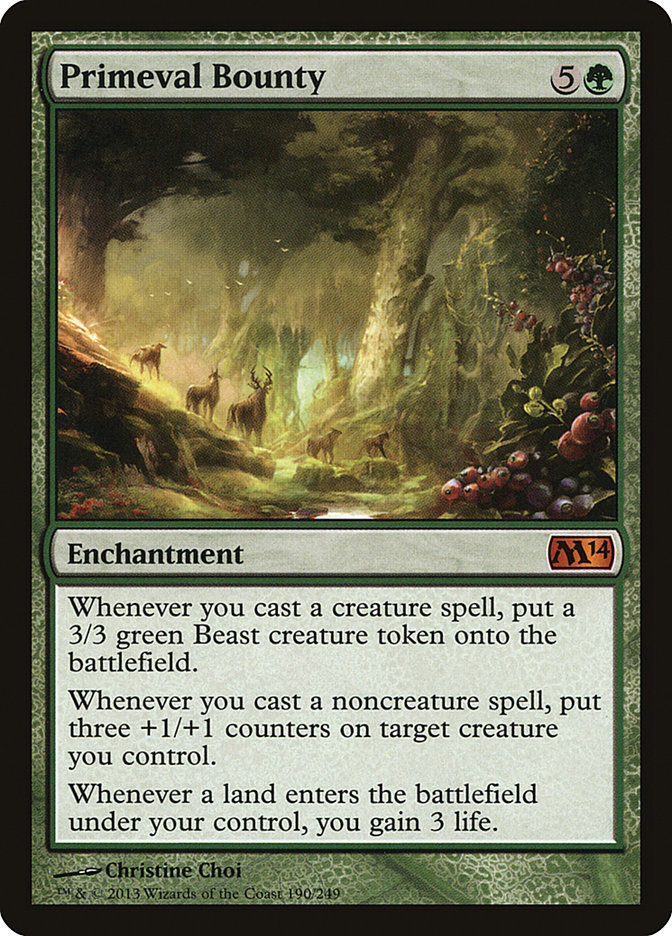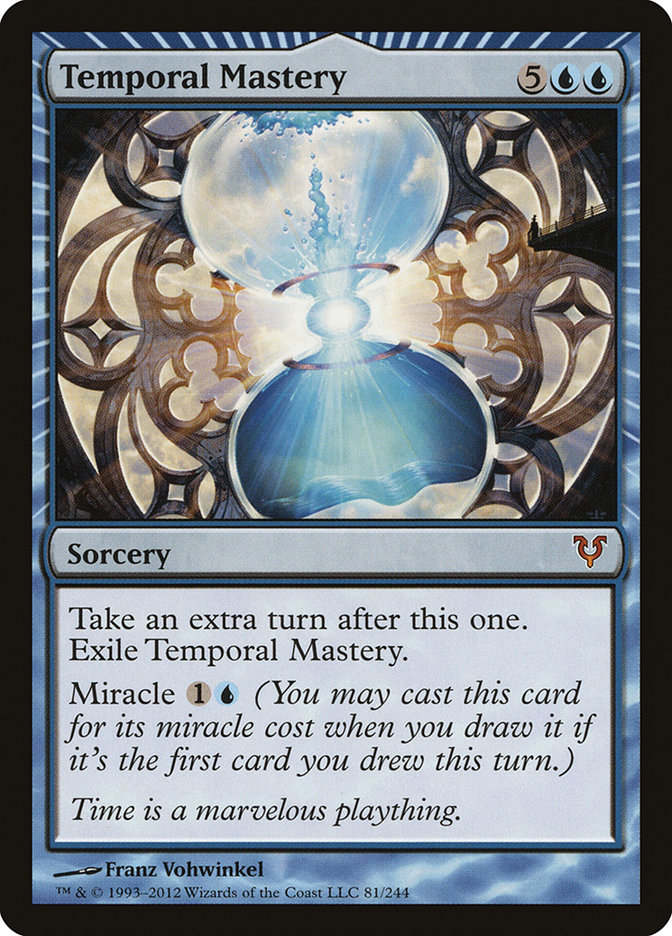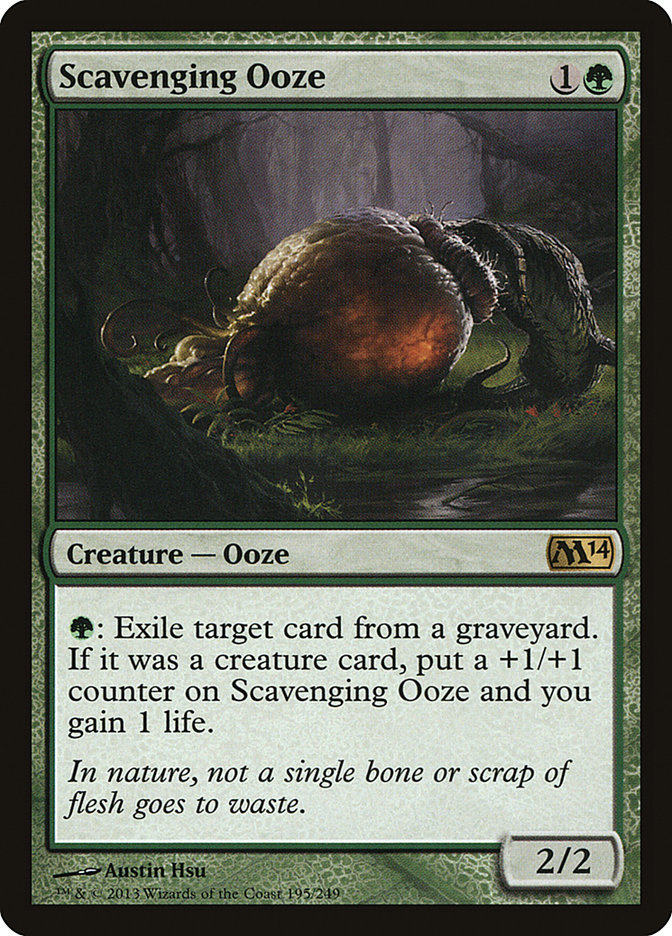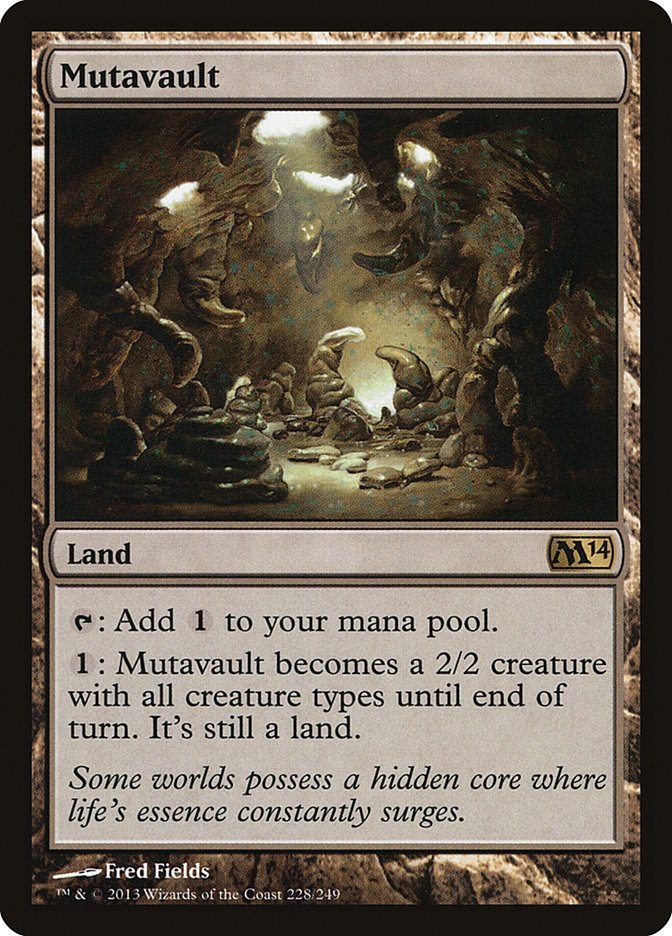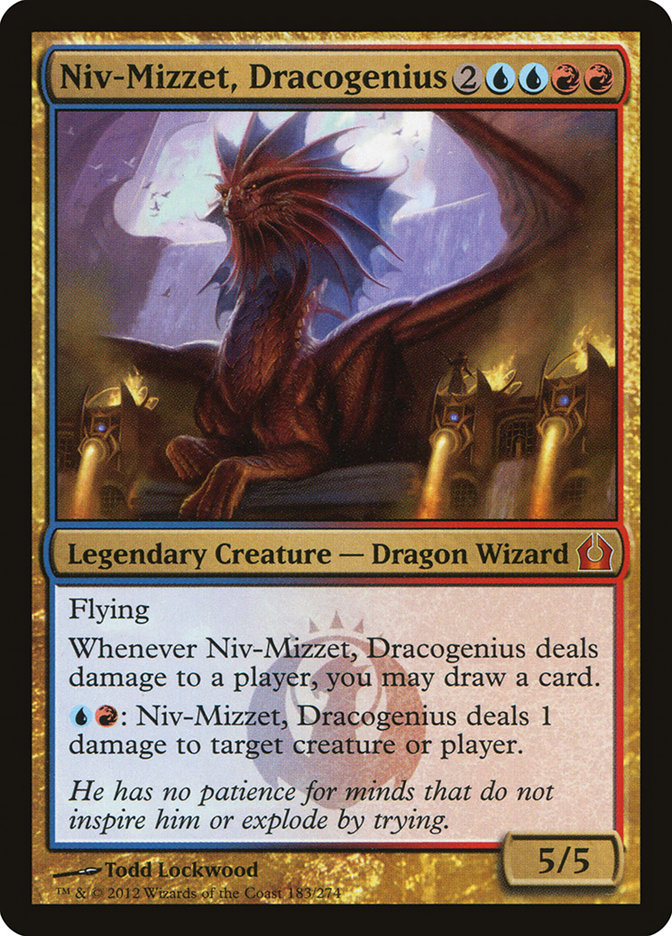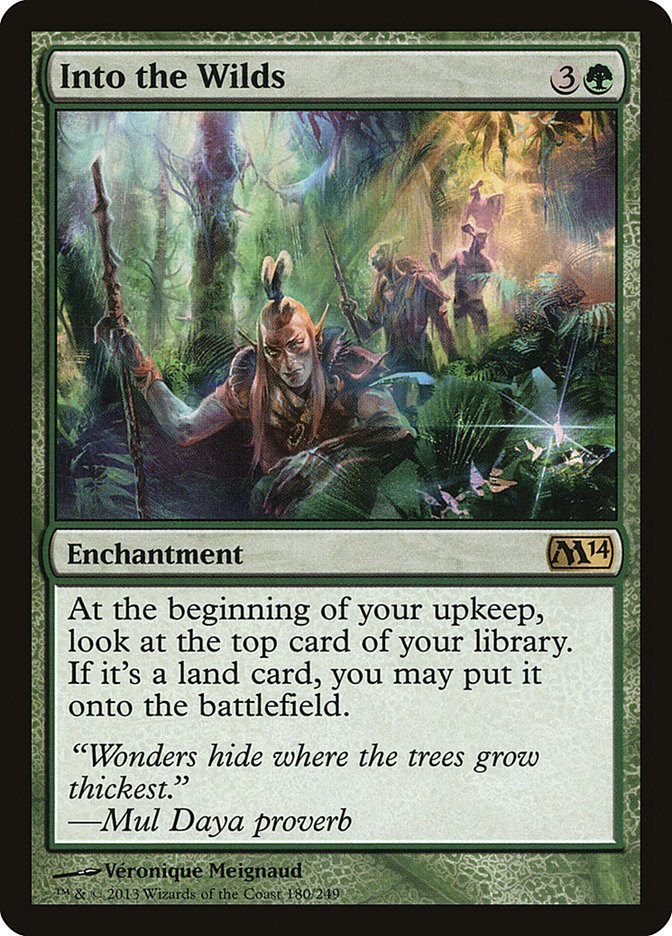First things first before I begin this week; it seems I’ll be appearing a little more often than I have been starting this week, as I’ll be published every Monday from here on out (barring some family issue which with four kids tends to happen sometimes). I hope this is not only exciting news for me but that it’s good news for you folks, as I truly hope my writing is well received and enjoyed.
On to the content!
I did have an article I’m pretty psyched about lined up for the first week of my weekly "columnistship" (don’t fight it, it is in fact a word . . . just trust me here), but unfortunately the kinks weren’t worked out as well as I’d hoped. I really want it to come out well, so definitely tune in next week for that. However, when one door closes, one more opens, and I’ve actually been pretty excited about my deck that I’ve recently been gaming with, so I’m going to take this week to talk about that with you folks!
It started a couple of weeks ago when I first looked into the cards in M14 and how we may be able to use them in Standard. After trying out Burn at the Stake at StarCityGames.com Standard Open: Richmond, I looked back at my article for any of my other ideas I might want to run. The B/W lists were pretty much invalidated by AJ Sacher win in Richmond since that deck was just much better tuned. The Jund thoughts and ideas were already included in most lists, so there was nothing exciting to try there. However, I’d yet to try a specific card that I was excited about:
The list I posted was mostly ideas that I thought I wanted to include in a RUG shell. That list, for reference:
Creatures (20)
- 4 Huntmaster of the Fells
- 3 Nightshade Peddler
- 4 Thragtusk
- 3 Niv-Mizzet, Dracogenius
- 4 Izzet Staticaster
- 2 Zhur-Taa Druid
Planeswalkers (4)
Lands (25)
Spells (11)

The first thing I did before even playing a game was to swap out Garruk Relentless for Tamiyo, the Moon Sage. The second thing I did was swap out the two Zhur-Taa Druids for two Manaweft Slivers. I debated including two Arbor Elfs instead, but since I’m simply including them as Farseeks five and six and don’t have the option of playing Underworld Connections out of the board, I settled for the consistency of Manaweft Sliver over the slight possibility of turn 2 Izzet Staticaster.
What I quickly discovered was that Primeval Bounty could have literally been anything else in that slot and probably would have done more work. The card seems like it does so much, but in the games where it "takes over" a Thundermaw Hellkite would be just as backbreaking. As would any number of planeswalkers. It just wasn’t as exciting as I hoped it would be.
In addition, I ended up cutting the Slivers, Staticasters, and Nightshade Peddlers. The Slivers were just far too fragile, and I wasn’t happy with them at all, so I swapped them out for Izzet Keyrunes. The Staticaster/Peddler combo just wasn’t good in this midrange format, plus I included them simply because Primeval Bounty gave them purpose in the late game/games where the combo didn’t matter. Since I was removing the Bounty, I might as well remove them as well.
I decided to push the deck to a more midrange deck aimed at casting and protecting the powerful planeswalkers the RUG color combination provides. Ral Zarek was awesome, even just as a ramp card that required an answer before it hit ultimate. Tamiyo, when dropped on a board that even somewhat resembled parity, would quickly take over and threaten to hit ultimate, which in and of itself required an answer as well.
I decided to try to push the deck more in that direction, even adding in a singleton Garruk Relentless to push the theme. I also tried to shift the deck to more resemble a "Blue Jund" deck by adding in Bonfire of the Damned.
Again, the deck was ok but nothing amazing. The thing that always impressed me was Ral Zarek and his ability to hit ultimate in a deck with Huntmaster of the Fells and Thragtusk. Once you hit ultimate with Ral Zarek, if you’re able to get three extra turns and have a backup ready to cast, you get to ultimate the second copy before they take another turn as well. This came up more often than you might think actually.
So I followed up that version with one that wanted to push the "extra turns" theme. Temporal Mastery is another card I touched on in my M14 Standard Musings article as something that I think people forgot even existed in Standard; I know I did for a time. I added four of those in as not only a way to take extra turns late but also possibly as a miracle version of my favorite card of all time, Explore. As Ali Aintrazi himself knows, taking extra turns is fun, but taking extra turns with planeswalkers in play is often backbreaking. While I ended up shaving down to two, I’m incredibly happy with them.
After messing around with some numbers and testing out various configurations, here is my current list. I’ll go into specifics on it after the jump:
Creatures (13)
Planeswalkers (6)
Lands (25)
Spells (16)

It seems I’ve got some splainin’ to do . . .
The Maindeck
First, I’m sure you noticed the two Scavenging Oozes in the main. While I know the card is amazing, it isn’t exactly what I’m looking for in this deck. It also isn’t great in multiples. What it fills in that spot is something to fit the curve at two mana while still being a good creature to just play. I don’t want too much of that effect because I typically want to use all of my mana early, but it is something I’m not unhappy to have in the games where I’m not casting Farseek on turn 2.
I’ve always been hesitant about running my favorite color combination in Standard because of the lack of decent removal options; Turn // Burn fixes that issue cleanly by giving us a great way to clear out big creatures that otherwise would be incredibly problematic. It is somewhat costly, but having the option of actually just getting rid of a Thragtusk no questions asked is a nice thing to have in RUG. You also have the option of the actual two for one, though that’s not the reason I play the card. It’s great in the aggressive matchups since it gives us a two-mana removal spell as well; not the most efficient, but it still gets the job done.
Bonfire of the Damned is there because I like having that out. However, since I’m looking to sculpt very specific board states with this deck, there’s somewhat of an argument to be made for just moving to Mizzium Mortars. I wouldn’t fault you if you make this move (I guess I’m just addicted to the big play . . . Niv-Mizzet activation during the opponent’s turn, miracle Bonfire for the massive blowout). Pillar of Flame is Pillar of Flame, but the reason I include two instead of, say, one Pillar of Flame and the fourth Turn//Burn is because of how cleanly you get to play Pillar of Flame on turn 3 after you’ve cast a Ral Zarek. This allows you to continue to build Ral Zarek while also protecting him.
Izzet Keyrune is a bit of technology borrowed from my Jund playing days with Rakdos Keyrune; granted, the creature you turn the Keyrune into might not be as strong in combat, but I have been incredibly surprised at how happy I’ve been including them. I’ll say this: post-rotation unless Theros gives us great mana fixing and artifact acceleration, Keyrunes should see a ton of play. They provide so much value and upside. Izzet Keyrune has allowed me to filter lands that I’ve been ripping into during the late game into bigger and badder spells while also being extra insurance against wrath effects.
Speaking of protection against wrath effects, you’ll see the split between Kessig Wolf Run and Mutavault: zero Wolf Runs, two Mutavaults. I originally started out the exact opposite but decided to give Mutavault a try on a whim; the singleton did so much work for me, whereas the Wolf Run barely came up as being necessary. I’m moving towards the two Mutavaults build but could easily be talked back into a 1/1 split.
In this build, Ral Zarek is awesome. This deck likes every single mode on Mr. Zarek. The ramp is incredibly appreciated; the ability to keep the board clean is awesome; and building towards the ultimate causes this awkward mini-game for our opponent that I love watching. "Searing Spear what? Ral Zarek? Sure, he goes down to four. Nice zero for one!" A cool note with Ral: if you’re able to get three heads on the ultimate with a backup in hand to cast that turn, you’ll get to continue taking free turns with the next copy as well.
Tamiyo plays incredibly well with Ral Zarek in addition to, well, anything else in the deck really. Against aggressive decks, she’s not overwhelmingly impressive, but whenever you can resolve her on a board with almost anything else, she will allow you to simply take over. A couple of observations about the Moon Sage that I’ve picked up:
1. The card is amazing in a format that leans towards the midrange/control spectrum. When testing against the B/G Midrange Desecration Demon deck, Tamiyo was far and away the single most important and best card in the entire deck. The ability to shut down your opponent’s main (only?) threat while building towards her ultimate was so backbreaking against a deck that has almost no way to actually pressure her.
2. Ultimating Tamiyo is probably the best thing ever; even with only a Farseek in hand when you do, you can just thin your entire deck of lands to make sure you’re hitting gas every turn. Obviously, with Pillar of Flame or Turn // Burn, you just win on the spot as well.
3. Imagine for a second that instead of being named "Tamiyo, the Moon Sage" she’s named "Jace, the Mind Sage" with the same cost and abilities. Imagine how much more she’d see play and be worth. Ponder on that for a bit.
Thragtusk and Huntmaster of the Fells are industry standard at this point, but I’ve gotten some sideways glances when playing the Dracogenius. I mentioned in the M14 Musings article about how Niv-Mizzet plays the role of Olivia Voldaren in this deck, but let me elaborate a bit further. You see, I never played Olivia for four mana against the decks I truly cared about having her stick around against. Like most, I would wait until I could play her with two mana up to get her to a 4/4 to eliminate the possibility of a Searing Spear. While this didn’t stop Mizzium Mortars, it did take away the option of using the number one removal spell in Standard to kill the Vampire noble.
With Niv-Mizzet, you get everything that Olivia provides in that you have a big flyer that allows you to dominate the board. However, since I considered Olivia a six-mana creature to begin with, Niv-Mizzet is an upgrade in that it comes down outside of the range of any burn spells currently being played in Standard with no additional investment. The only downsides at that point when compared to Olivia are that Niv-Mizzet isn’t black (Doom Blade) and that Niv-Mizzet doesn’t grow while pinging. However, the ability to draw cards based on however much mana you have available (in addition to attacking) more than makes up for that minor issue since it makes Niv-Mizzet incredibly relevant against control decks.
While I have a hard time believing such a powerful creature hasn’t seen play up until this point, I know why it’s the case. First, it’s very mana intensive and also color intensive; unlike Olivia, you need two colored mana to use the Dracogenius. Second, Aetherling plays the same role in decks that can cast it and usually gets the nod even if Niv-Mizzet is an option.
In this deck, just like in Jund, mana isn’t an issue. Between Farseek, Izzet Keyrune, and the ability to push into the late game, you’ll have plenty of mana available. Also, look at that mana base; with the exception of Mutavault, each land (and Keyrune) can help activate Niv-Mizzet. When I Farseek, I look to fix my mana first, but if color isn’t an issue, I stick with Steam Vents and don’t waste time considering other options. Niv-Mizzet also does something that Aetherling never could: control the board. Thus why I prefer it over Neo-Morphling.
The Sideboard
The sideboard is the part I’m most excited about though. You’ll see some singletons meant to fill in the fourth slot for some cards in the main. However, there are a couple cards I want to make sure to touch on.
First, if Turn // Burn was the reason I became ok with running the deck, Ratchet Bomb was the other card that alleviated some concerns I had running the RUG color combination. It isn’t a spectacular removal spell for anything other than tokens, but it’s solid and will get the job done eventually. With Ral Zarek, you can build Ratchet Bomb up much quicker as well, so keep that in mind.
Natural End answered another big concern of mine: Burning Earth. I was concerned about a decent answer and found Natural End and Sundering Growth; while the upside on Sundering Growth is rather substantial (getting an additional Beast/Wolf occasionally versus three life), the double green mana is actually relevant in this deck. Natural End does invalidate the life loss when casting it, making it an incredibly clean answer regardless of what life you’re at (you can tap the mana, put the triggers from Burning Earth on the stack, and cast Natural End with all of the triggers still on the stack, gaining the life first then taking the three damage from Burning Earth and coming out even). Also, having a Disenchant effect is actually relevant in other ways in Standard since Pithing Needle, Ratchet Bomb, and Detention Sphere are common cards out of U/W/x decks.
Finally, the card I’ve gotten the most sideways looks total (yes, even over Niv-Mizzet): Into the Wilds. I’ll say this: if I were playing Jund, this card would definitely be in my sideboard since I know I’m going to see a ton of Jund mirror matches. Why, you might be asking, would this be of relevance?
I played Jund for a while; it was my "go-to" deck. Probably still is if I had to play in a Standard Pro Tour tomorrow. Every single Jund mirror match I’ve ever played has either been won by an unreciprocated Rakdos’s Return or by whomever topdecks better in the late game (presuming two competent pilots). Into the Wilds makes flooding less of a possibility while also ensuring you’re drawing into as much gas as possible while still getting ahead on mana. Think about it this way: if you’re in a topdeck war and you never hit lands and your opponent does one-third of the time, you’re going to start pulling ahead.
The card fits the same role in this deck, although it does nothing to answer Rakdos’s Return. In all reality, this deck is probably a bit too cold to a fast Rakdos’s Return, but I don’t know if I want to play Negates to answer that. Right now I’m ok without them, but that could change in the future. The third Mutavault in the board also comes in whenever you want to bring in Into the Wilds since you want to hit with it and it gives you extra action against control decks.
Playing the Deck
On the surface, it looks as if we’re playing another Jund deck. To some extent we are; turn 3 Huntmaster of the Fells, turn 4 Thragtusk is still very good. However, you sometimes simply play out your best creatures and hope they’re enough to win the game for you in Jund, whereas in RUG Midrange you have more of an ability to sculpt a game state where you turn the game irreparably in your favor. The planeswalkers do a great job of allowing you control over your opponent’s game plan in order to construct your own, and Temporal Mastery gives you the ability to completely turn the corner on unsuspecting opponents. I have cast Mastery for the full mana cost way more than I have miracled it because it affords me the chance to get max value out of it.
Against aggro decks, you have plenty of early removal to help stem the bleeding until you start dropping Huntmasters and Thragtusk; it sucks to do, but dropping Ral Zarek as a four-mana removal spell (and a way to soak up some damage) is a necessary evil against aggro. Tamiyo isn’t great here and could feasibly be boarded out in addition to Temporal Mastery.
Against midrange decks, you want to bring in the Tamiyo, Into the Wilds, and Mutavault in addition to possibly some number of Ratchet Bombs as a catchall. Ground Seal obviously comes in against Junk Reanimator and any type of U/W/x deck with Snapcaster Mage. (Quick aside: I chose Ground Seal over Scavenging Ooze out of the board because post-board our opponent will have ways to kill Ooze, making Ground Seal a bit more permanent of an answer).
Against control, you bring in the same cards as the midrange matchups, but you also look to bring in some number of Natural Ends for Assemble the Legion, Detention Sphere, Pithing Needle, etc. It’s a great catchall to have. I keep in my Turn // Burn against U/W/R decks because a lot are bringing in Thundermaw Hellkites and you need a way to answer it.
Some cool interactions while playing the deck:
- Huntmaster of the Fells and Niv-Mizzet in play allows you to flip Huntmaster without losing value at all; in fact, if you pump all of your mana into pinging the opponent, you’ll draw into enough spells to reflip Huntmaster the next turn if you see fit (if you prefer to just keep drawing cards with Niv-Mizzet, I wouldn’t disagree with you at all either)
- Building Ral Zarek to ultimate sometimes involves simultaneously building Tamiyo; if you have a Tamiyo Emblem, you can continue trying to take "infinite turns" by trying to hit 3+ heads on Ral Zarek every time you ultimate him (and put him back into your hand) or you can play Ral Zarek after ultimating, shoot for three, take the next turn, shoot for three again and recast Ral Zarek, bolting your opponent again. This can be repeated each extra turn if it’s going to kill our opponent instead of trying for a bunch of extra turns.
- Ral Zarek gives pseudo-vigilance to our creatures.
- Ral and Tamiyo allow us to tap down our U/W/x opponent’s mana in the first main phase to force through whatever spells we need to.
- Niv-Mizzet allows us to miracle spells on our opponent’s turn. I know I covered this before, but in a deck that doesn’t play Think Twice, this feels really good.
- Remember: you play blue mana! Leaving mana untapped during an opponent’s turn, even if only because you couldn’t play anything on that turn, is an incredibly powerful play. Remember this when tapping your lands; even if it "doesn’t matter" how you tap, tap in such a way that it looks obvious that you’re leaving up blue mana. I’m telling you, this has an effect on opponents’ actions.
There are a ton of intricacies that are impossible to fully touch on (because there are a lot of corner cases); if you play Jund now but think you might need a change, give this deck a shot and you’ll get a feel for how many decisions you get to make with it.
(Even if you stick with Jund, give Into the Wilds a shot; I was never unhappy when I resolved that card.)
I’ve had a blast playing with this deck, and unless something happens between now and SCG Open Series: Baltimore later this month, I’ll probably run this one. I’m sure it’ll shift around quite a bit between now and then, but I’m excited to give it a shot.
If you decide to run this or are thinking about it, either let me know in the comments or talk to me on Twitter about it. I try to answer everyone, so please let me know if you try this out!
Thanks for reading; tune in next week, as I’m going to dive into reading the opponent’s thoughts and how that can help us in a game of Magic. I’ve been putting a lot of research into this piece and am really looking forward to publishing it. I’ll see you then!
Thanks for reading,
Michael
@mikemartinlfs on Twitter
Mikemartinlfs (at) gmail (dot) com

